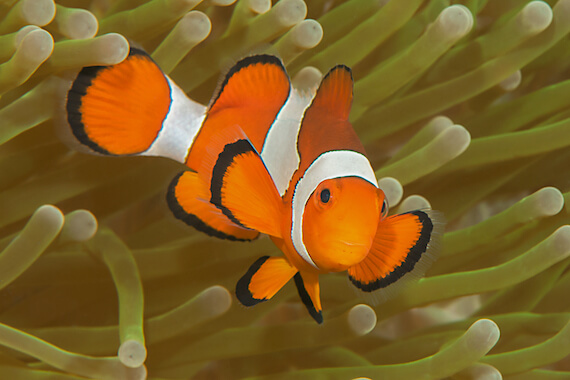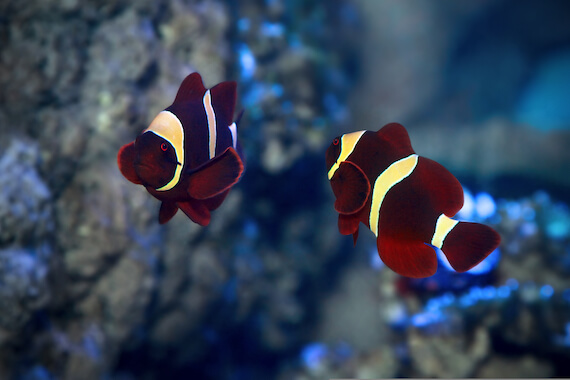
| Kingdom | Animalia |
| Phylum | Chordata |
| Class | Actinopterygii |
| Order | incerti ordinis |
| Family | Pomacentridae |
| Subfamily | Amphiprioninae |
| Genus | Amphiprion; Premnas |
| Species | 30 different species |
| Niche | Omnivorous tropical reef-dwelling fish |
| Length | 2.8 – 6.7 inches (7 – 17 cm) |
| Lifespan | 6 – 10 years |
| Social Structure | Small groups with a few males and a single female |
| Conservation Status | Least Concern |
| Preferred Habitat | Reefs at the bottom of warm, shallow seas |
| Average Clutch Size | 100 to 1500 eggs |
| Main Food Item | Zooplankton |
| Predators | Eggs preyed on by other fish and brittle stars |
The Basics
Clownfish, or anemonefish, are a group of tropical reef fishes found in the warm waters of the Indian Ocean, Red Sea and western Pacific Ocean. There are 30 recognized species of clownfish, all but one of which belong to the genus Amphiprion. The only species in the genus Premnas, the maroon clownfish, is distinguished from all other clownfish by the presence of a spine on its cheek.
The most well-know species of clownfish, thanks to the popular film Finding Nemo, is the ocellaris clownfish. Although the name clownfish reflects the bright orange pigmentation and white stripes of this and other species, not all species look the same. Clownfish range from being pale pink though to dark brown and have varying numbers of white or even golden stripes.

Clownfish live at the bottom of shallow seas at depths of 10-50 feet (3-15 m) in sheltered rocky or coral reefs. Their alternative name, anemonefish, reflects the symbiotic relationship these fish form with sea anemones. Clownfish are omnivores and eat a variety of prey items, but feed primarily on zooplankton including copepods, isopods and tunicate larvae. In addition to this, clownfish also eat algae, as well as the uneaten prey items and dead tentacles of their host anemones.
Clownfish associate in small groups consisting of a single, monogamous breeding pair and a few non-breeding juvenile males. A strict dominance hierarchy exists in each group, whereby the female is always the largest, followed by the breeding male. The smaller non-breeding males decrease in size further down the hierarchy.
Clownfish reproduce via external fertilization in which females lay their eggs on a flat rock surface close to their host anemone, then males swim over the eggs and fertilize them. Females lay between 100 and 1500 eggs depending on their maturity. Spawning occurs around the time of the full moon, possibly so that hatching coincides with high tides, which might help hatchlings escape predators by sweeping them away. Clownfish eggs typically hatch 6-10 days after fertilization, depending on the water temperature.
The taxonomic order of clownfish is currently uncertain as it is not known exactly how they relate to other groups of fish. Although clownfish species were historically identified and grouped using morphological features, modern genetic techniques have revealed the true relationships within the clownfish subfamily, conveying that genetic relatedness does not always correspond with morphological similarity.
Fun Facts about Clownfish
Clownfish have evolved a number of adaptations that help them survive and reproduce in their reef habitat, so demonstrate several interesting biological concepts.
Mutual Interests
Clownfish and their sea anemone hosts form mutualistic symbiotic relationships, in which both species benefit from their interaction. Other types of symbiotic relationships may be commensalistic, in which one species benefits from the interaction and the other is not affected, or parasitic, in which one species benefits but the host species is harmed.

Individual clownfish species are host-specific, but most often form relationships with species of the Stichodactylidae family. Clownfish derive a number of benefits from their mutualistic relationship with sea anemones. For example, the tentacles of anemones provide protection from predators both for adult fish and for nearby nests. Uneaten prey and dead anemone tentacles also provide a food source for clownfish.
In return, anemones benefit from this relationship via the nutrients they gain from clownfish excrement, which aid growth and regeneration. Additionally, clownfish protect anemones from their predators and eat their parasites. The bright colors of clownfish might also help attract anemone prey. Finally, the movement of clownfish around anemones increases water flow and therefore aeration of the tentacles, which aids both anemone and clownfish respiration and metabolism.
Although sea anemones are predators that use a toxic venom to paralyze their prey, clownfish are not affected by this. These fish have adapted to living inside their predator host by evolving a mucus coating that protects their skin from the anemone’s sting. Even so, clownfish must still acclimatize to their hosts by rubbing themselves against the stinging tentacles when they enter.
Changing Sex
Clownfish are protandrous sequential hermaphrodites, which means that all individuals are initially male, but can develop into females in later life. Not all male clownfish become female, however, as only those at the top of the male hierarchy have the chance to do so.
When the sole female in a group dies, the largest male, which is also the only breeding male, develops into a female to replace the one that has been lost. The largest non-breeding male will then take his place as the breeding male and all other non-breeding males will move up a place in the hierarchy. It is thought that the non-breeding males regulate their size in this way in order to reduce competition for access to the single female. By presenting no threat to the dominant male, they are less likely to be evicted from the group, so can patiently await their turn as the dominant male in safety.

Female clownfish are aggressive in order to maintain their dominance over the male fish in the group. This prevents the males from developing into females and ensures that the dominant female has no competition for mates. As a result, the dominant female can be sure to produce all the offspring in her group.
One model that explains why clownfish might be sequential hermaphrodites is the size-advantage model, which postulates that individuals of a given sex reproduce more effectively if they are of a certain size or age. Thus, smaller individuals are more successful as one sex, whilst larger individuals are more successful as another sex. In the case of clownfish, the number of eggs a female produces depends on her maturity, thus it is possible that individuals only become female once they are large enough to produce many eggs.
Paternal Care
As is common for fish species, parental care of clownfish offspring is carried out by the males. Once a female has laid her eggs, the male guards and cares for them throughout the incubation period. Males help the eggs develop by fanning them with their fins to increase water circulation and therefore oxygen supply. Males also eat any eggs that are infertile or damaged by fungus. However, this period of paternal care ends once clownfish eggs hatch, after which the juveniles must fend for themselves.

Although male-only parental care is relatively rare amongst mammals, birds and reptiles, it is more common in amphibians and is in fact the most prevalent form of parental care in fish. It is thought that paternal care might have evolved in certain fish species due to the territorial behaviour of males. This is because it is not particularly costly for a male that is already guarding a territory, as is the case with clownfish, to also guard eggs within that territory.
